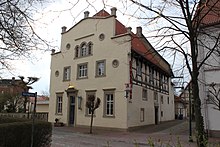Kalandstrasse 5 (Warburg)
The house Kalandstraße 5 , also known under the name Hirsch Pharmacy is a built in the late Middle Ages building complex in Warburg . It is under monument protection and is entered in the list of architectural monuments in Warburg .
history
The property was owned by the Geyr family until the 17th century . This had spread in the 12th and 13th centuries from Cologne via Paderborn to Warburg , acquired a large fortune through long-distance trade and had risen to the rank of patriciate of the city of Warburg and nobility in the principality of Paderborn . From 1288 to 1643 family members are repeatedly mentioned as counts of Warburg, mayors and councilors.
A quarry stone house is said to have been built on the property as early as 1396. The building that still exists today was built in 2 construction phases in the middle of the 15th century: from 1452–1453, today's rear building was first rebuilt over a massive vaulted cellar. It was called " Haus am Kaland " because its entrance was on Sternstrasse opposite the former Kalandhaus . Just two years later, in 1454–55, a large stone house added it to today's Kalandstrasse. In 1481 Dethmar Gyr was councilor in Warburg. In 1490 his son Johann Geyr von Warburg zu Leuchten († 1510) was enfeoffed with clearing in Waldeck . In 1599 Herbold Geyr († 1643) was a geographer and mayor. He was married to Anna von Menne and had at least four sons: Johann Bernard Geyr stayed in Warburg, where he was able to preserve his assets even during the Thirty Years' War despite the burdens of billeting and, with six other Warburgers, belonged to the highest tax bracket. Two other sons studied at the University of Paderborn from 1643 and 1655 respectively . Peter Geyr (1609–1683) moved to Cologne and rose there up to the court councilor and general collector of the Electorate of Cologne . As recently as 1725, the Warburg mayors von Hiddessen and Koch attested to their predecessors in office " that Geyr and Gerold did not use a mechanical profession, but were from ancient patricians and noble families ".
In 1613, under Herbold Geyer , a pharmacy was set up in the house for the first time , which was run by Ludwig Bolte . In 1699 Philipp Ernst and Gottfried Wüstenberg were named as pharmacists. They had apparently acquired the house from the Geyr family and had it completely rebuilt and redesigned as a residential and commercial building for their purposes in 1705-06. After the Battle of Warburg on July 31, 1760, the British Lieutenant General John Manners, Marquess of Granby, was fed from the house for a few weeks. From 1790 the house and pharmacy belonged to a Gödecke family . She had it redesigned again in 1843 and given a classicist facade decoration after the upper echelons of the street gable were demolished. It was followed in 1864 by the pharmacist Niemer and in 1874 by the pharmacist Hense . In 1908 the pharmacist Ludwig Küpper acquired the property, his son Josef Küpper and his grandson Edmund Küpper continued the business there until 2012.
building
The main parts of the house are still in their condition from 1452–55. The rear building with its vaulted cellar and the imposing half-timbered structure of the rear building with its stud walls extending over two floors and the half-timbered floors protruding several times over knags is the oldest dated half-timbered house in Warburg and the region. It probably comprised two floors of living space, above a storage floor and further storage floors in the compartment.
The front building, which is arranged slightly at an angle and is largely solid, does not have a basement and probably had a commercial hallway accessible at ground level , above which there were additional storeys. Between the two parts of the house there is a fire wall that extends up to the roof and contains a fireplace that can be used by both parts of the house .
Literature and web links
- Monument topography Federal Republic of Germany , monuments in Westphalia, district Höxter, volume 1.1 .: The city of Warburg ,, edit. by Gotthard Kießling, Michael Christian Müller and Burkhard Wollenweber, with contributions by Peter Barthold, Hans Joachim Betzer, Daniel Bérenger, Franz-Josef Dubbi, Horst Gerbaulet, Detlef Grzegorczyk, Fred Kaspar, Hans-Werner Peine, ed. by the Landschaftsverband Westfalen-Lippe and the Hanseatic City of Warburg, LWL monument preservation, landscape and building culture in Westphalia, Imhof-Verlag , Petersberg 2015, ISBN 978-3-7319-0239-3
- Elmar Nolte: On the secular building of the medieval city of Warburg. In: Franz Mürmann (ed.): The city of Warburg. 1036-1986. Contributions to the history of a city. Volume 2. Hermes, Warburg 1986, ISBN 3-922032-07-9 , p. 150.
- Hans Tisje: Dendrochronological report, Neu-Isenburg November 5, 1984, StA Warburg
- MyHeritage.de, accessed June 13, 2019
- Warburger Kreisblatt: From an old Warburg family: General Geyr von Schweppenburg , Warburg, August 6, 1941
Individual evidence
- ^ New general German Adels Lexicon Volume 3, page 507.
- ↑ DWUD, deed dated April 9, 1385
- ↑ Monument topography 2015, p. 267
- ↑ Hans Tisje 1984
- ↑ Hans Tisje 1984
- ↑ DWUD, deed dated February 22, 1481
- ^ Warburger Kreisblatt 1941
- ↑ Inscriptions on the lintels of the side entrance and the garden gate
Coordinates: 51 ° 29 ′ 17.1 ″ N , 9 ° 8 ′ 56.9 ″ E


